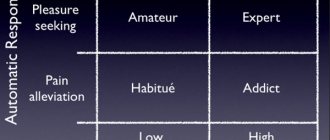Definition of the concept
What is a stereotype? A stereotype in a broad sense is an established pattern of behavior , a cliche, a prejudice.
Often stereotypes have nothing to do with reality; they are created by people’s thinking based on superficial data.
The word consists of two: “stereo” - “solid” and “tipos” - “imprint”, literally an imprint in our brain of a certain concept.
Beliefs may concern a specific group of people, for example, the presence of a specific characteristic of race, behavior, traditions. Often lead to erroneous perceptions.
Difference from prejudice
These two concepts are similar, but at the same time they have differences.
The first term, stereotype, is a kind of generalization, often of a collective nature , that is, a group of people is convinced of the existence of a certain phenomenon.
For example: all Russians are lazy. A person may not even understand why he agrees with certain stereotypes, but he believes and accepts them.
Prejudices are more personal in nature , often appearing after an individual has gone through difficult events.
A woman has been abandoned by a man, and she begins to believe that the entire stronger sex has a set of negative traits and should stay away from men.
A person may be aware of the presence of specific prejudices and be critical of them.
Read about the types of people's attitudes towards their illnesses here.
Stereotyping effect
Stereotyping - what is it in psychology? The term means the process of forming a stable idea or image. They relate to phenomena, events or people.
Based on his own experience, a person evaluates an event or phenomenon, and as a result, a certain idea is formed, which is fixed in the brain. A stereotype is an already formed attitude towards an object or phenomenon.
When a person encounters something unfamiliar, his brain begins to scan and look for something familiar .
The resulting image belongs to a specific group of phenomena, which makes it much easier to classify information and, if necessary, pull it out of memory cells.
The mechanism of stereotyping
The emergence of certain psychological clichés occurs in people when generalizing their experience, knowledge of society (books, Internet, television, etc.) under the influence of certain physiological factors.
The idea of the emergence of stereotypes is clearly presented in D. Kahneman’s book “Think Slowly and Decide Fast.” Its essence is this: an individual has two thoughts.
- System 1. This is intuitive and fast thinking. It is automatic and error prone. It can be compared to the subconscious.
- System 2. Can form certain judgments about events or people and act consciously. A parallel can be drawn with consciousness.
And despite the fact that System 2 can make conscious choices, it often follows the lead of the spontaneous and automatic System 1.
Similarly, prejudices and stereotypes are laid down at the level of neural connections (or can be formed under the influence of any phenomena), therefore an unconscious prejudice can take over higher-order thinking and force one to think (or act) in exactly this way.
Stereotypical thinking and behavior
Thinking in stereotypes - what does it mean?
This kind of thinking means that a person thinks mainly in patterns.
He does not search for or analyze new information, filling the brain with experience, but compares it with what is in his memory .
It’s easier this way, it seems that the world is subject to some order.
The program can be instilled from childhood. These are attitudes, values, rules of behavior, reactions to events, assessment of people and events.
The presence of predominantly stereotypical thinking interferes with the full development of personality . Independence in views and behavior is lost.
Stereotypical behavior - what is it? This is patterned behavior encouraged by society. The individual lives like everyone else, does not stand out, tries to merge with the general mass. She is so comfortable and comfortable. Patterned behavior ensures calmness and merging with society.
Stereotypes allow actions to become automatic, but they also hinder development and do not allow one to look at the situation from a different perspective. With stereotypical behavior, there is an attitude: do only this way and not otherwise.
Stereotypical person - what is he like? This is a completely ordinary, typical representative of society. His behavior is determined by built-in attitudes, skills, and traditions.
It is difficult for such a person to deviate from patterns, and she perceives something new critically and even aggressively , since it violates internal harmony and tranquility. He has a pattern of behavior, and he acts and thinks according to it.
Stereotyping perception
By this phenomenon it is necessary to understand something about which an individual can form a certain subjective opinion, based on the factors described earlier plus on the beliefs that arose during perception.
For example, an opinion about a person (or interlocutor) seen for the first time can be formed based on the following data:
- Anthropometric. Scientists have proven that a beautiful person initially evokes great sympathy and trust.
- Emotional and aesthetic. For example, when hiring a person in a formal suit, initially there is greater respect and trust in his professional skills. And a person who smiles is more likely to make you believe his words and buy even a low-quality product offered. At the same time, a potential buyer will not “hear” and will not buy a gloomy person offering quality products, despite his logical arguments.
- "Projections on oneself." Often people attribute positive qualities to a person they find attractive, which they themselves have, and vice versa.
- By sociological groups. If it is initially known which group a person belongs to, this often greatly influences his perception. For example, a teacher is strict, attentive, hardworking, and a child who does poorly is lazy, a hooligan, and difficult to educate.
So, under the influence of the perception of a person seen for the first time, personality stereotyping occurs. That is, based on your feelings and experience, you form an opinion about him. And based on this, stereotyping of communication arises. For example, we will not allow ourselves to shout at an expensively dressed person for whom respect has arisen and talk to him with disdain. But if the same person stands in front of us, but, for example, a former alcoholic or a prisoner, then most likely he will not evoke sympathy and respect; more “harsh notes” may slip into communication.
Stereotyping of communication also includes rules and norms of behavior, social attitudes in various situations, etc.
In conclusion of the article, I would like to say that biased judgment and the emergence of certain cliches in our minds often interfere with living and thinking more broadly. Therefore, before forming a final opinion about people or events, it is necessary to analyze all the information, and not be based only on feelings or imposed stereotypes. At the same time, we should not exclude the positive role of clichés: rules of behavior in society, in certain cases (for example, avoid unlit streets at a late time or before coming to friends, even for a short visit, it is advisable to call so as not to make people uncomfortable position).
Advantages and disadvantages
pros:
- automatic behavior and thinking that is necessary in some situations;
- the ability to classify objects and phenomena, which facilitates the thinking process;
- protect from worries;
- allow you to be in a specific social group.
disadvantages of stereotypical behavior :
- lack of freedom of action and thinking;
- low rate of self-development;
- acting according to patterns, which interferes with the perception of new information and learning;
- mistakes if the situation deviates from the usual, and the person is not able to move away from patterns;
- trust in information, lack of critical analysis, perception of the data received as it is, only because the majority thinks so.
What are stereotypical attitudes?
Below I will describe in more detail the most common models that exist in the social paradigm.
Gender stereotyping: women and men
- A girl is an emotional, unreasonable, weak creature. Her mission is to give birth, run the house and take care of the man.
- Every girl needs to learn how to apply makeup, dress beautifully and behave properly around boys, in order to later find someone who will fully provide for her and her children.
- Strong ladies are usually loners.
- A single mother is an unhappy, abandoned victim.
- A business woman has no time for family values.
- A man should be a little more handsome than a monkey. His task is to earn money to provide financially for the woman. They don't need love, they only want sex.
- Representatives of the stronger sex should not express their feelings or perform “feminine” duties: cooking, washing.
- A real man must work, support his family, and drive a car.
The above examples of common stereotypes show that many people do not see an individual personality behind a particular person. Due to the huge number of cliches that we receive in childhood, problems arise in relationships: partners are simply not able to hear and understand the position of the other half.
During my consultation, you will be able to destroy many illusions regarding energy. You will find your resource state, realize your own importance and move to a new level of development of your individuality.
Children
They are obliged:
- Listen to adults in everything.
- Fulfill the unrealized plans of parents.
- Get good grades in school.
- Go to university in agreement with mom and dad.
- Don't be smart.
At the same time, it is believed that all kids are ugly, they cannot be trusted with anything, they break and spoil things. The younger generation is dissolute, stupid, young people are not aware of what they are doing.
Happiness
The essential elements of a happy life are:
- Money.
- A dream come true.
- High social status.
But in fact, each person has his own system of coordinates, values and desires. You have the right to decide for yourself what is important to you.
"Correct"
- Only in elite universities can you get a good education.
- “Normal” people get jobs regardless of their desires. You don't have to like the activity.
- You need to live in your homeland, and not move to another country.
- It is necessary to follow trends.
- You need to dress in expensive stores.
- You cannot live without faith in God.
- The opinion of an individual must correspond to the position of the majority.
Who is considered the author of this theory?
The term was coined in the 20s of the last century. The author is believed to be journalist Walter Lippmann .
He borrowed it from the printing industry. Initially, the word “stereotype” meant a printed form. It allowed the text to be reproduced many times.
Auto believed that stereotypes:
- are not developed by man, but are imposed from the outside;
- they are false;
- simplify the perception of reality;
- exist for a long time, firmly entrenched in people’s minds.
What is the difference between higher and lower human needs? Find out the answer right now.
What it is
Stereotyping began to be considered in the 20s of the twentieth century. Stereotypical thinking is characterized as a narrow paradigm that is stored in the head to save effort required when perceiving certain complex situations and phenomena. Researchers have identified two reasons for the formation of such patterns: the economy of the mind and the desire to preserve the values of a particular group.
This kind of standardization has the following characteristic features:
- sustainability;
- selectivity;
- emotional basis.
Simply put, people use stereotypes so as not to bother themselves with additional thinking. When they manage to find confirmation of their thoughts in the behavior of others, they become even more convinced of the truth of their own or collective conclusions. Stereotyping is a certain replacement for mental activity.
To one degree or another, each of us is subject to such beliefs, with the only difference being that some truly firmly believe in such “postulates,” while others are able to question them.
Various kinds of prejudices influence a person’s worldview, his behavior and encourage a distorted vision of reality. Patterns can be imposed by society or arise based on personal observations. The former are more harmful, since they impose an incorrect way of thinking on the individual and do not allow him to analyze the situation objectively and independently.
But still, without stereotyping, society could not exist. It allows consciousness to build important patterns:
- water may wet;
- it's cold in winter;
- the flame burns.
Knowing this, we do not need to verify our assumptions in practice every time. However, there are stereotypes that affect a person’s consciousness and subconscious, preventing him from living.
You should learn to distinguish prejudices from the real state of affairs. The same concept can be dictated by the internal motivations of an individual or imposed on it by society. In the second case, the individual feels a conflict between his interests and what public opinion requires of him. The desire to follow stereotypes imposed from the outside distorts the vision of the real.
Often we judge others not by their actions, but by what others say about them. For example, a person who occasionally attends church may assume all the characteristics of a real Christian, although in fact this is not the case at all.
Types and examples
What are the stereotypes? Researchers, psychologists and sociologists identify different types of stereotypes :
- social stereotype;
- ethnic stereotypes;
- stereotypes of perception;
- stereotypes in communication;
- gender stereotypes in modern society;
- heterostereotypes;
- age stereotypes;
- gender role stereotypes;
- modern stereotypes;
- common stereotypes;
- social stereotypes.
Stereotypes are superficial , formed by external assessment. For example, the stiffness of the British, the bright character of the southern peoples, the laziness of the Russian people.
Superficial stereotypes change depending on the international situation, the development of society and other factors.
Deep ones are more stable, passed on from generation to generation. For several centuries, samovars, furs, and nesting dolls have been considered obligatory companions of Russian traditions.
Such stereotypes are difficult to break.
Attributes that are no longer part of social life may still be used as examples of cultural heritage or for commercial purposes.
Deep stereotypes can be formed under the influence of historical events .
The special conditions of origin of Great Britain led to the creation of stereotypes that the people of this country have developed logical thinking, prudence, and pragmatism.
Examples of stereotypes:
- women - evil;
- a successful career is possible with the presence of “connection”;
- Jews are a cunning people;
- a man promised - he is obliged to do;
- boys are not allowed to cry;
- you can’t take a woman on a ship - it means trouble;
- high price means high quality;
- Bears walk the streets of Russia;
- The French are excellent lovers.
There are many such examples in our lives, and often we don’t even notice that we think in stereotypes; they become part of our perception of the surrounding reality.
Distortions of perception and understanding in the process of communication
When we meet a person, dozens of different mechanisms come into motion in our psyche, and all this happens in seconds, that is, sometimes subconsciously. The process of perceiving an interlocutor is very complex; in this article we will try to find out the main points of how a person decides whether he likes a communication partner.
In social psychology, the perception of a person by a person is the process of constructing an image of another, which unfolds during direct communication with him. It has special temporal characteristics and includes all levels of mental reflection.
If we talk about conscious perception, then first of all a person pays attention to the appearance of the interlocutor: hairstyle, eyes, expression and symmetry of the face, expressive body movements, and other features. During the dialogue, ideas are formed about his abilities, character traits, emotional states, interests - all this is very often grouped together.
Conscious perception is formed from four components that are used in assessing and perceiving another person:
- Emotional : we form an opinion about a person based on his attractiveness or unattractiveness. It is especially important whether you are comfortable with him. If yes, then we give it a positive rating.
- Analytical : here each element of appearance is perceived as a form of manifestation of a personality trait. Sloppy dressed and with a beard - a programmer, wears glasses - a scientist or botanist.
- Social-associative : we attribute character traits and personality traits to a person based on the social group to which he belongs.
- Perceptual-associative : we perceive a person based on his similarity with our friends or public figures (first love, enemy, famous actor).
However, this is just a conscious perception, and there are also unconscious ones - which is why this process is so intricate. We'll talk about it later.
It is also worth saying that we ourselves want to look a certain way in the eyes of others and put a lot of effort into this. Or at least we want to understand what impression we are making. This means that a situation often arises that can be called “I think that he thinks that I think that he thinks.”
This process can take place at three levels (depending on the situation):
- I look at him and see that he is looking at me.
- I look at him and, seeing that his eyes are fixed on me, I try to imagine what impression I make.
- I look at him and, seeing that his eyes are fixed on me, I try to imagine what impression I make, and also how he imagines the impression I make on him.
You can remove the most complex level and highlight six figurative figures that appear when the conditional Igor and Alexander take part in the dialogue:
- real Alexander;
- Alexander's idea of himself;
- Igor's idea of Alexander;
- real Igor;
- Igor's idea of himself;
- Alexander's idea of Igor;
It is obvious that the human brain is not able to separately and adequately process such a complex structure, which is why complete chaos arises in the head. Such multi-tiered representations can cause misconceptions. For example, any facial gesture on the interlocutor’s face can be interpreted completely incorrectly and will complicate both communication and getting the right impression of the person.
But if you are able to imagine what another person imagines about you, this is only a plus, and not at all unnecessary mind games. This way you can understand how you appear in the eyes of people and adjust your behavior. “I don’t care how others perceive me” is the wrong approach for people seeking successful communication.
Many of our communication problems, however, arise from a reluctance to ask the simple question: “Is it just me, or do you perceive me as such and such?” Of course, you may receive an insincere answer, but from now on your interlocutor will be conscious of his perception, so the chance that you will be perceived correctly increases.
Settings of perception
Quite often we mistakenly and distortedly perceive the personality, actions and behavior of other people. It happens that our eyes seem to open to the true essence of a person, although, most likely, he has always been like this, and we only allowed ourselves not to notice it.
Psychologists believe that there are three types of attitudes towards the perception of another person: positive, negative and adequate. With a positive attitude, we overestimate the positive qualities of the interlocutor and give a small advance, although in fact we behave trustingly and do not realize it.
With a negative attitude, we tend to exaggerate the shortcomings of a particular person, and downplay or ignore his merits. Here we are dealing with stereotypes, cognitive distortions and prejudice. Mistrust and suspicion arise.
Correct installation is adequate. In this case, we understand that there is no purely black or white, and we evaluate both the positive and negative qualities of a person. Rather, we are interested in the personality itself and its uniqueness.
Other psychologists understand the term “attitude” differently. In their opinion, a social attitude is a person’s unconscious readiness to perceive and evaluate people in a certain habitual way and to react in a pre-formed way without a full analysis of a specific situation.
These attitudes are formed under the influence of:
- personal experience that is gained in repeated situations;
- parents, friends, media, environment, social norms accepted in the cultural environment.
These settings have three dimensions:
- Affective dimension: positive or negative emotions, attitude towards a specific person or information.
- Cognitive Dimension: The beliefs and opinions that a person holds about a person or thing.
- Behavioral dimension: readiness for certain behavioral reactions that correspond to a person’s beliefs and experiences.
How we interpret the information that enters our senses (mainly visual) and brain is very important. Prejudice and biased attitudes are formed precisely at the stage of interpretation, because before that the world is objective.
An event or a person in our life does not mean anything in itself, but we give it meaning through interpretation. And it, in turn, depends on many factors. We talked about external ones, now let's discuss internal ones.
All our attitudes take the form of stereotypes and cognitive distortions. Once you begin to wage a fierce struggle with them, you will learn to perceive people as objectively as possible and avoid many misconceptions.
Stereotypes and cognitive distortions
A stereotype is a simplified, often distorted, idea of a social group or individual belonging to a particular community, characteristic of the sphere of everyday consciousness.
Stereotypes arise for two reasons: mental laziness and lack of information and time. For example, we have a few seconds to either trust a person or close ourselves off from him: we use external, superficial characteristics, look at his race, gender and age. Stereotypes, in fact, form attitudes.
Cognitive distortions also change our perception. These are systematic errors in thinking or patterns of bias in judgment that occur in certain situations. Their existence has been confirmed by many experiments, so this is no longer a theory.
We've written a lot about cognitive biases, so for now we'll just give three typical examples:
- The primacy effect: the first information heard or seen about a person becomes very significant. Moreover, it matters what mood you were in at that time.
- The novelty effect: when it comes to someone you know, the most recent, new information becomes the defining information in perception. Any unexpected action, non-standard act of a loved one forces one to conclude that there are certain personality traits that were not noticed before.
- The Pygmalion effect: you get the feedback from the person during the conversation that you were counting on. If you wanted a closed interlocutor (or were very afraid of this) - with a high degree of probability he will be like that or will be perceived by you as such.
Analyze your thoughts for stereotypes and cognitive distortions. To do this, think back to your last few meetings with strangers or acquaintances. Be as clear as possible.
How to be objective?
We will give you three tips, following which you will be able to perceive a person (or event) more adequately and objectively.
- Observe more and talk less about the conclusions you reach. These are two sequential processes and the second part is completely optional. An observation is simply a description of what you heard and saw, while a conclusion is our interpretation based on cognitive distortions, stereotypes and beliefs.
- When describing another person, use less words like “he never” and “he always” and instead say “to a greater or lesser extent.”
- Describe more than evaluate. You should not rely on black and white thinking, where all people are “bad” or “good”, “good” or “evil”.
If you want to communicate with people and do it as effectively as possible, you need to be objective, but also understand how others perceive you. Sometimes we cannot reach an agreement for this reason alone, so practice as often as possible.
We wish you good luck!
Did you like the article? Join our communities on social networks or our Telegram channel and don’t miss the release of new useful materials: TelegramVKontakteFacebook
We also recommend reading:
- Storytelling
- How to make a good first impression
- The influence of social roles on personality development
- Mental processes: types and brief description
- Socialization of personality: briefly about the main thing
- Psychic reflection
- Social perception
- Character and temperament
- Interpersonal attraction and its factors
- “I-concept”: characteristics, features, meaning
- Carpenter effect
Key words:1Cognitive science
How are they formed?
Stereotypes are passed on from one generation to another , which is why it is so difficult to protect yourself from them.
Already in early childhood, adults lay down the principles of behavior in the child, instill in them how to act, react, and think correctly.
The influence of society and the specific country of residence is great.
If stereotypes are formed for the benefit of society, then they are moral standards that are customarily adhered to. Patterns of behavior help to adapt to society. The child is sent to school, explaining the rules of behavior and the need for education.
However, inharmonious personality development leads to the fact that it is easier and calmer for a person to act and think in stereotypes than to take risks and create something new.
Those who deviate from the rules achieve much more.
How to fight stereotypes
On the one hand, templates help relieve the mind from excessive stress. But at the same time they become limiters of thought.
- You should not blindly believe everything that is accepted in society. Check the data received from outside and draw conclusions based only on your own experience.
- Highlight those behavior patterns that exist in you, but have not been practically confirmed. Try to prove them or abandon them.
- Find a refutation of those attitudes that have no factual or logical basis.
How have they changed with the development of society?
With each generation, gender behavior and the stereotypes associated with it change slightly. What was previously unacceptable is now considered commonplace . If previously marriage and its preservation were important, now many couples live without signing, and divorces happen much more often.
The role of women has also changed. She is increasingly striving for a career, occupying positions previously considered male. At the same time, the stronger sex follows the opposite development towards acquiring feminine traits.
Previously, a woman was the keeper of the hearth, a mother, now she provides for the family on an equal basis with a man. Moreover, modern society respects working women more than housewives.
What are human social needs? You will find the list on our website.
Functions
Researchers and psychologists have identified various functions of social stereotypes.
W. Quasthoff describes the following:
- Cognitive. Occurs when there is a need to organize information. If something new is studied, for example, the culture of another people, then some stereotypes can be replaced by others.
- Affective - distinguishing “one’s own” and “them” from other people.
- Social . Formation of social structures, identification of categories.
There are also other functions of social stereotypes :
- installation of communication. When a person communicates with a stranger, the brain reads the information, compares it with what is stored in memory and decides how to continue the communication. For example, a person will talk to a general and a beggar differently.
- association in social groups, when members of the community and strangers are separated:
- simplifying the analysis of incoming information and reducing its processing time.










